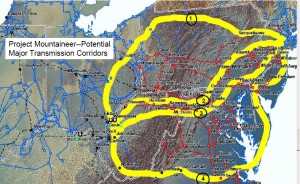JP Morgan Chase and MISO – abusive practices!
July 7th, 2012
.
“MISO” trademark owned by… JPMorgan Chase!
But seriously folks! JPMorgan got caught with its hand in the cookie jar again, CAISO and MISO have filed claims of abusive practices at FERC. Here’s the short version of what they allegedly did (it’s allegedly for now, but just you wait!) — from the second article below:
In the Midwest, the alleged manipulation involved day-ahead margin assurance payments, under which generators are compensated for situations when their real-time dispatch falls below the level set by the day-ahead dispatch schedule. As in California, traders found a flaw where they could force the market to make “inappropriate or excess” payments by placing lowball bids in the day-ahead market – as low as negative $500 per megawatt-hour – and much higher bids in the real-time market, Miso said.
Here’s the Amended CAISO Petition against JPMorgan Chase:
Still looking for the MISO Petition and FERC’s legendary Constellation Order.
In the news:
JPMorgan Chase Manipulation Scandal Raises Specter of Enron
NPS pressured about Susquehanna-Roseland EIS
July 21st, 2011
First, the bad news – the Commonwealth Court of Pennsylvania has affirmed the Order of the Pennsylvania Public Utilities Commission approving the Susquehanna-Roseland transmission project:
Commonwealth Court of Pennsylvania – Affirms Pennsylvania’s S-R Order
And now, on to the pressure… The National Park Service is working to do it’s job as steward of our national park land, in this case, the federally declared Wild and Scenic Delaware River and the Delaware Water Gap.
Seems that some don’t think they should be allowed to do that job, and are pressuring them to “hurry up” so the Susquehanna-Roseland transmission line can steamroll on through. Well, BACK OFF!
Today the pressure on NPS was overt in two venues. First, U.S. Rep. Charlie Dent (R-PA) amends a bill to push the NPS to complete its environmental review one year ahead of schedule. Say what?!?!?!
Then in my inbox a sour grapes press release from FERC Commissioner Phillip Moeller whining because the newly adopted rule won’t do what he wants, it won’t address “problems” like NPS doing its proper review of transmission projects:
Here’s the Susquehanna-Roseland specific part:
“While I offer substantial praise for today’s final rule, the Commission should have taken a different approach to several important issues. We must recognize that all of the nation’s difficulties in building needed transmission will not be resolved by this rule. Rather, this rule largely addresses planning for long-distance transmission lines, which is only a subset of the critical issues that are inhibiting needed investment.
This rule cannot address issues like the delays caused by other federal agencies in the siting of important projects, as this Commission lacks the legal authority to require other federal agencies to act. For example, see the comments of PJM in this proceeding at p. 17, which state that:
[t]he PJM Board approved the Susquehanna-Roseland 500 kV line in 2007. The Susquehanna-Roseland line was approved by the state regulatory commissions in Pennsylvania and New Jersey for 2012. The line is currently delayed by the National Parks Service [sic] and is not expected to be in service until 2014 at the earliest.
Ohhhhhhhh, isn’t it too bad. He’s just one Commissioner, and he’s got to put his dissent out there as an extensive and extended rulemaking proceeding closes… Why is he pushing, why does he care, and why does his care rise to the level that he sends out a dissenting press release? Lighten up, the National Park Service has a job to do. As the testimony in the Susquehanna-Roseland proceeding before the New Jersey Board of Public Utilities reflects, we are NOT going to freeze in the dark in an incubator without a job…
And here’s Pre. Charlie Dent’s whine:
Charlie Dent pushes expedited federal review of Susquehanna-Roseland power line proposal
Published: Thursday, July 21, 2011, 4:30 AM
By Tom Rowan Jr. | The Express-TimesAnd the New Jersey Sierra Club wants Dent, R-Lehigh Valley, to back off.
If it passes through the House, it would be referred to the Senate.
ILSR’s Farrell on Fed Transmission Scam
June 29th, 2011
ILSR’s John Farrell is halfway there – he recognizes the federal part of the transmission equation, but the state part is missing, for example, Minnesota’s special eminent domain exemptions for “Public Service Corporations” (particularly where the transmission is for private profit, NOT public service), rate recovery for “Construction Work in Progress” and state regulators refusal to examine the interstate nature of transmission proposals. And the third part of that unholy trinity — in the Midwest, bulk power transmission would not be being built but for the Settlement Agreement – ME3(Fresh Energy), Izaak Walton League (and Walton’s program Wind on the Wires), Minnesota Center for Environmental Advocacy, and North American Water Office. This glut of transmission is their legacy. It takes all three to build transmission.
From Grist, today:
Feds running a high-voltage gravy train for power transmission
by John Farrell
28 Jun 2011 6:00 AM
Even as distributed generation shows economical and political advantages over centralized renewable energy, the Federal Energy Regulatory Commission (FERC) is running a high voltage gravy train in support of expanded transmission. FERC’s lavish program is expanding large transmission infrastructure at the expense of ratepayers instead of looking at more economical alternatives.Since 2007, FERC has had 45 requests for bonus incentives for transmission development — authorized under the 2005 Energy Policy Act — and has provided all or most of the requested incentives in more than 80 percent of the cases. With the bonuses, the average return on equity for utilities for their new transmission investments is nearly 13 percent. This high rate of return is a full 2.5 percentage points higher than the median utility return on equity [PDF], a value considered just and reasonable by state public service commissions in ordinary times. However, these rewards came during a time when unemployment doubled, the stock market tumbled, and most corporations were lucky to have any profit.The ratepayer impact of these bonuses is significant. In a November 2010 criticism of FERC transmission awards, Commissioner John Norris noted that the 2 percent bonus FERC provided to the PATH high-voltage project on the Eastern seaboard would “cost [Maryland] ratepayers in PJM at least $18 million per year.” The bonus payments were also given in concert with other incentives that reduced risk, including rate recovery during construction and guarantee of payment if the facilities were abandoned for reasons outside utility control.
FERC cost-apportionment docket heats up
February 24th, 2010
The cost apportionment remand at FERC is heating up. It’s that case where the 7th Circuit threw out the PJM cost apportionment scheme:
It went back to FERC and so FERC issued an Order requiring PJM to produce things that… well… things that will demonstrate that there’s no need for this project, things that will demonstrate the benefactor of these transmission lines, things that PJM doesn’t really want the world to know, like how they’ve incorporated O-P-T-I-M-I-Z-A-T-I-O-N, things going directly to N-E-E-D!
Seeing that, well, Stop the Lines had to join in, as did the Municipal Intervenors:
PJM begged for more time, an extension of 45 days!
And for some bizarre reason, FERC gave it to them:
Meanwhile, Exelon wants to bring in the kitchen sink, including 345kV transmission:
And parties they are a freakin’ and filing:
And then the weirdest of all – the American Wind Energy Ass (AWEA) wants to intervene, citing “the current significance of this issue in the context of efforts to build transmission to bring location-constrained, renewable resources to load…” Ummmm… SAY WHAT??
OK, I give up… in what parallel or alternate universe is the PATH or Susquehanna-Roseland line for wind? WHERE DO THEY GET THESE IDEAS? I want to see the basis for that statement. PRODUCE!
Earth to AWEA — can you spell P-R-O-J-E-C-T M-O-U-N-T-A-I-N-E-E-R?
If you need a hint, go to FERC eLibrary and search for A05-03. Happy reading!
Susquehanna-Roseland reopened!
January 27th, 2010
The Susquehanna-Roseland hearing has been reopened. And off we got to FERC. It’s been quite a hectic week, with a “flurry” of filings, and here’s the update. First, remember the NJ BPUat a special 1/15 meeting said they were NOT going to decide on PSE&G’s Susquehanna-Roseland transmission line and said they’d be asking for more information from PJM. Well, they asked PJM to answer a few questions (though not specific enough, not the right questions):
Here’s what PJM had to say:
Suffice it to say, the letter is … ahem… INSUFFICIENT!
And then the responses started coming in, first the Municipal Intervenors, then :
Municipal Intervenors response to PJM Letter
And the BPU issued an Order reopening the docket and first scheduled a hearing for February 2, 2010, and then THANKFULLY changed it to February 4, 2010:
The concept is that PJM is coming in as a witness regarding the assertions of their January 21, 2010 bullshit letter, and what does that mean? Is Steve Herling THE witness, or are there others? Is whatever witness/es coming with a truckload of exhibits that they’ll dump on us the day of the hearing? Is he going to be prepared in any way to back up his conclusory and unsupported statements? So I fired off a couple missives, first Discovery to get the requests in quick and let them be on the record of ignoring or refusing to answer, and then a letter to the BPU with my view of the fine mess we’re in:
As a sidebar, the escrow that PSE&G had to put out for the Municipal Intervenors is gone, this has been an intense case, and so they’re reasonably asking for more:
Meanwhile, back at the ranch, remember that great 7th Circuit decision tossing out the cost allocation for this project? Everything’s been up in the air since then, because if they can’t settle how they’re going to allocate the costs, this sucker won’t be built:
It was remanded to FERC and after some wrangling, just like in the BPU case, where the utilities were saying, “It’s all there in the record, you don’t need anything more to make a separate decision” and Illinois said quite succinctly, “AHEM, WE DON”T THINK SO!” and FERC issued an Order stating that the record was not sufficient, needed more information and directed PJM to provide some information and also provided some questions for parties to mull over in their comments:
Here’s the fun part – what they asked PJM to provide (hee hee hee hee hee hee), starting on p. 5 of the above Order:
10. PJM should provide the following information:
A. The total costs that have been approved through PJM’s Regional Transmission Expansion Plan (RTEP) process for facilities that operate at or above 500 kV (and necessary lower voltage facilities), and whose costs are assigned pursuant to Opinion No. 494. For these projects, calculate the total costs that have been assigned to each PJM zone, and estimate the total costs that would be assigned to each zone using PJM’s DFAX methodology.
B. PJM manuals require that, in planning projects, it seek to optimize projects in order to reduce the cost of addressing individual reliability criteria. Describe how the optimization process is performed. Also, explain how PJM determines the relative priorities of resolving numerous reliability issues with one project. For 500 kV and above facilities, explain whether PJM could accurately determine the beneficiaries of a project that resolves numerous reliability issues using its DFAX methodology.
C. PJM’s most recent RTEP report (2008), at P 5 states that:
Baseline thermal and voltage analysis encompasses an exhaustive analysis of all Bulk Electric System (BES) facilities for compliance with NERC Category A (TPL-001), Category B (TPL-002) and Category C (TPL-003) events. In addition, consistent with NERC standards TPL-004, a number of extreme events including those judged to be critical from an operational perspective as well as those defined in Table I of TPL-004 were evaluated for risk and consequence to the system. Describe the types of anticipated reliability requirements addressed by the PJM RTEP (i.e., voltage, thermal, stability). Explain whether and how the DFAX analysis applies to the NERC reliability analyses listed above and any other reliability requirements. Explain whether the RTEP upgrades designed to address these reliability requirements also will address other reliability concerns. In particular, explain whether the geographic location or voltage level of an RTEP upgrade makes that upgrade more likely to address broader reliability concerns.
Provide any relevant studies.D. In this proceeding, PJM recommended the adoption of a postage-stamp rate design for new 500 kV and above facilities.
1. Describe the benefits generated by such facilities that are not captured in the DFAX methodology used by PJM to allocate costs for lower voltage facilities. Indicate whether such lines provide reliability or economic benefits to the areas producing electricity.
2. Provide engineering or other studies showing any differences in regional benefits between 500 kV and lower voltage facilities (e.g., 345 kV
and 230 kV).E. Provide any existing engineering or other studies that indicate whether the modeling assumptions used in the RTEP analysis, such as the direction of flow,
remain consistent or vary over time.
The Municipal Intervenors sent in a Motion to FERC, PSEG objected, and then Stop the Lines sent in a Motion for Limited Intervention:
Municipal Intervenors – Motion to Intervene
PSEG Response to Munis FERC Intervention
Stop The Lines! Motion for Limited Intervention
PSEG’s response to our Motion to Intervene… yeah… (yawn)… what-ev-er…
And just now, hot off the press, the Municipal Intervenors have filed a Motion to Depose PJM’s Steven Herling! Oh, yes, this is much needed, so we can get an idea where they’re going and what they plan to present (I doubt they’d produce the pre-filed testimony I requested!):
As you can see, it’s been an intense few days, and isn’t letting off anytime soon. More to follow as it develops.







